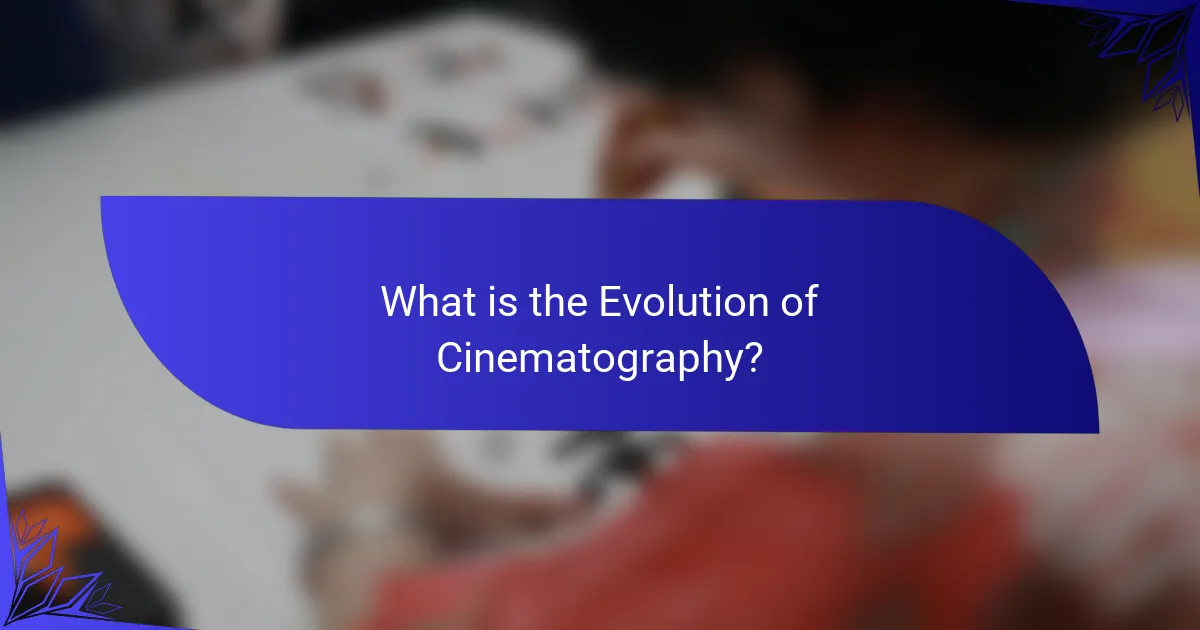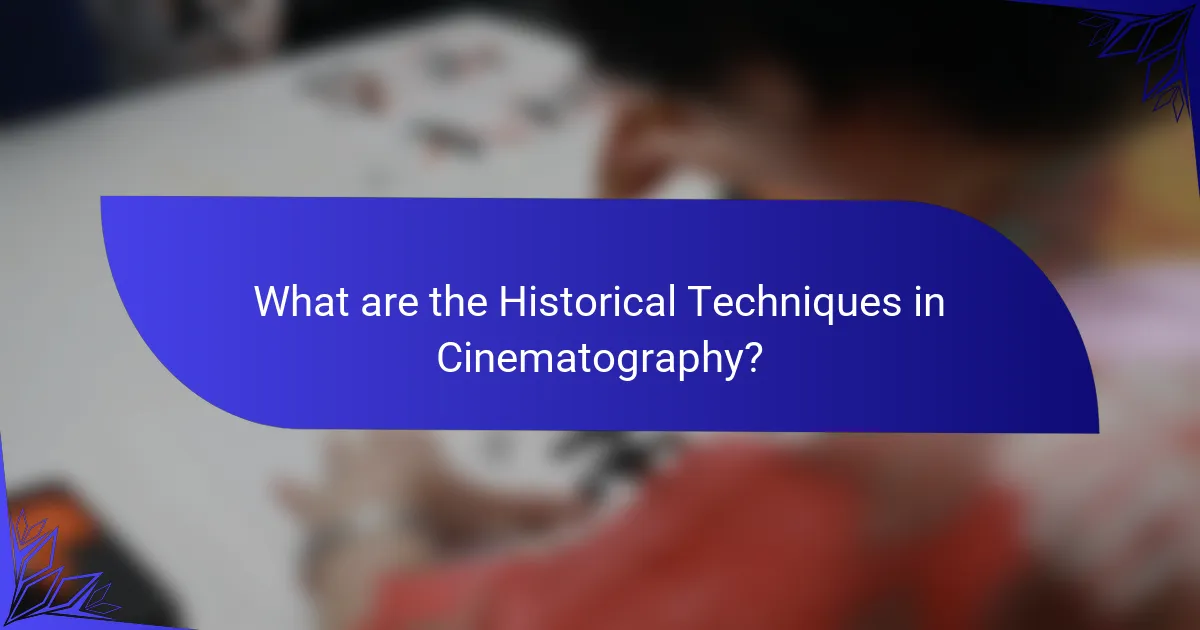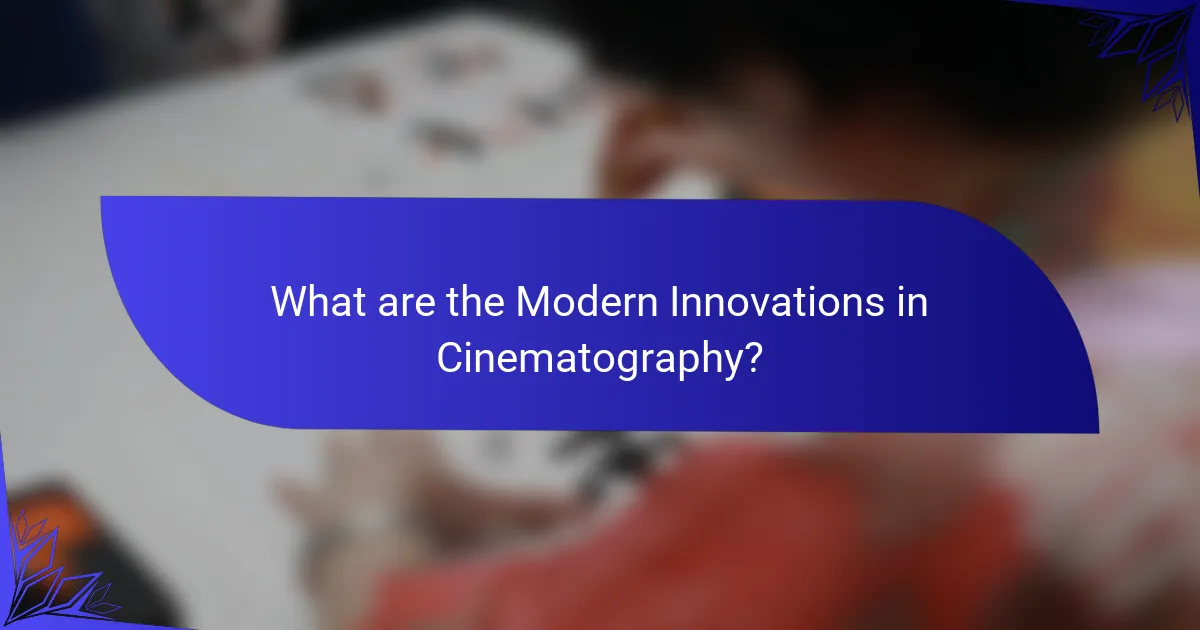Cinematography is defined as the art and technology of capturing motion pictures, with a rich history that dates back to the late 19th century. This article outlines the evolution of cinematography, starting from early devices like the kinetoscope and Cinématographe, through significant milestones such as the introduction of color film in the 1930s and the transition to digital technology in the late 20th century. Key historical techniques, including static cameras and hand-cranked film cameras, laid the groundwork for modern practices. The article also explores contemporary innovations, such as digital cameras, drones, and virtual reality technology, which have transformed the filmmaking process and enhanced visual storytelling.

What is the Evolution of Cinematography?
Cinematography is the art and technology of capturing motion pictures. It has evolved significantly since its inception in the late 19th century. Early cinematography began with devices like the kinetoscope and the Lumière brothers’ Cinématographe. These innovations allowed for the first public screenings of films in 1895. The introduction of color film in the 1930s marked a major milestone in cinematographic evolution. Advancements in camera technology, such as the development of the 35mm film format, further enhanced the quality of films. The transition to digital cinematography began in the late 20th century. This shift allowed for greater flexibility and efficiency in film production. Today, technologies like high-definition cameras and CGI continue to shape the future of cinematography.
How has cinematography changed over the decades?
Cinematography has evolved significantly over the decades. Early films used static cameras and limited lighting. The introduction of sound in the late 1920s required new techniques for capturing audio and visuals. During the 1950s, color film became popular, enhancing visual storytelling. The 1970s saw the rise of handheld cameras, allowing for more dynamic shots. Digital technology emerged in the late 1990s, revolutionizing the industry with greater flexibility and lower costs. Today, advanced digital cameras and editing software enable filmmakers to experiment with visual styles and effects. This progression reflects changing artistic trends and technological advancements in filmmaking.
What were the key milestones in early cinematography?
The key milestones in early cinematography include the invention of the motion picture camera, the first public screening of films, and the development of film editing techniques. In 1891, Thomas Edison and his assistant, William Kennedy Laurie Dickson, created the Kinetoscope, a device for viewing moving pictures. This marked a significant advancement in capturing motion. In 1895, the Lumière brothers held the first public screening of films in Paris, showcasing short films to an audience. This event is often credited with launching cinema as a popular medium. Additionally, in 1903, Edwin S. Porter released “The Great Train Robbery,” which introduced innovative editing techniques, such as parallel editing and narrative storytelling. These milestones collectively laid the foundation for modern cinematography.
How did technological advancements reshape cinematography?
Technological advancements reshaped cinematography by introducing digital cameras and computer-generated imagery (CGI). Digital cameras replaced traditional film, allowing for easier editing and higher-quality images. They also reduced production costs and time. CGI enabled the creation of visual effects previously impossible with practical effects. Innovations like drones and gimbals improved camera movement and stability. High-definition and 4K resolutions enhanced image clarity. These advancements have transformed storytelling capabilities in film and television. The shift to digital also democratized filmmaking, making it accessible to more creators.
Why is cinematography important in filmmaking?
Cinematography is crucial in filmmaking because it shapes the visual storytelling. It influences how audiences perceive emotions and narratives. Effective cinematography utilizes lighting, camera angles, and shot composition. These elements create mood and atmosphere, guiding viewer engagement. Studies show that visual elements can enhance emotional responses. For instance, a well-lit scene can evoke feelings of warmth or tension. Cinematographers use techniques like depth of field to direct focus. This enhances the storytelling by highlighting important details. Overall, cinematography is essential for conveying the filmmaker’s vision and connecting with the audience.
What role does cinematography play in storytelling?
Cinematography plays a crucial role in storytelling by visually conveying emotions and themes. It shapes the audience’s perception of characters and events. Techniques such as camera angles, lighting, and shot composition influence narrative pacing and mood. For example, a close-up can evoke intimacy, while a wide shot can establish context. Historical techniques, like chiaroscuro lighting, enhance drama. Modern innovations, such as digital cinematography, allow for greater creativity and flexibility. Studies show that effective cinematography can significantly impact audience engagement and emotional response. This underscores its importance in the storytelling process.
How does cinematography influence audience perception?
Cinematography significantly influences audience perception by shaping visual storytelling. It employs techniques such as framing, lighting, and camera movement to evoke emotions. For example, close-ups can create intimacy, while wide shots establish context. Different lighting styles can convey mood, such as high contrast for tension or soft lighting for warmth. The choice of color palettes affects emotional responses; warmer tones can evoke comfort, while cooler tones may induce melancholy. Research indicates that visual composition directly impacts viewer engagement and emotional resonance. A study by the University of Southern California found that specific cinematographic choices can alter audience interpretation of narrative events. Thus, cinematography is a powerful tool in guiding how stories are perceived and felt by audiences.

What are the Historical Techniques in Cinematography?
Historical techniques in cinematography include the use of static cameras, hand-cranked film cameras, and early lighting techniques. Static cameras were often employed in the early 20th century to create stable shots. Hand-cranked film cameras allowed filmmakers to control the speed of filming, influencing motion portrayal. Early lighting techniques relied on natural light or simple artificial sources to illuminate scenes. The use of practical effects and matte paintings was common for creating visual depth. These techniques laid the foundation for modern cinematography. They influenced the development of camera movement and lighting design in contemporary filmmaking.
What were the foundational techniques used in early films?
The foundational techniques used in early films included static camera placement, simple editing, and basic lighting. Static camera placement involved positioning the camera in a fixed position to capture action. This technique allowed filmmakers to focus on the performance without complex movements. Simple editing techniques included cuts between scenes without advanced transitions. Early films often utilized natural light or basic artificial lighting to illuminate scenes. These foundational techniques set the stage for the development of more complex cinematographic methods. The first known films, such as “The Horse in Motion” (1878) by Eadweard Muybridge, exemplified these techniques. Early filmmakers relied on these methods to tell stories visually, paving the way for future innovations in cinematography.
How did silent film techniques differ from sound films?
Silent film techniques relied heavily on visual storytelling and physical expressions. Actors used exaggerated gestures to convey emotions due to the absence of spoken dialogue. Text cards were often inserted to provide dialogue or context. Cinematography focused on visual composition, lighting, and camera movement. Sound films introduced synchronized audio, allowing for dialogue and sound effects. This shift led to more naturalistic performances and richer storytelling. The use of sound altered editing techniques, pacing, and audience engagement. Historical data shows that the transition began in the late 1920s with films like “The Jazz Singer,” marking a significant evolution in film techniques.
What innovations came with the introduction of color in film?
The introduction of color in film brought several key innovations. It enhanced visual storytelling by allowing filmmakers to convey emotions and themes more vividly. Color differentiation enabled audiences to better distinguish characters and settings. The use of color also led to advancements in cinematography techniques. Filmmakers began to experiment with color palettes to create mood and atmosphere. The introduction of Technicolor in the 1930s marked a significant technological leap. This process allowed for more vibrant and realistic colors on screen. The impact of color films increased audience engagement and box office appeal. Overall, color transformed the cinematic experience, making it more immersive and dynamic.
Which historical figures significantly impacted cinematography?
Georges Méliès significantly impacted cinematography. He is known for pioneering special effects and narrative storytelling in film. Méliès created the first science fiction film, “A Trip to the Moon,” in 1902. His innovative use of techniques like stop motion and multiple exposures transformed cinematic storytelling. D.W. Griffith is another key figure in cinematography. He developed narrative techniques, such as cross-cutting and close-ups, in films like “The Birth of a Nation” (1915). His work laid the foundation for modern film editing. Additionally, Sergei Eisenstein contributed to cinematography through his theories on montage. His film “Battleship Potemkin” (1925) showcased the power of editing in conveying emotion and meaning. These figures collectively shaped the evolution of cinematography and influenced future filmmakers.
What contributions did pioneers like Georges Méliès make?
Georges Méliès significantly contributed to the early development of cinematography. He is known for pioneering special effects in film. Méliès utilized techniques such as stop motion and double exposure. He created the first narrative films, transforming cinema into a storytelling medium. His most famous work, “A Trip to the Moon,” showcased imaginative visuals and innovative editing. Méliès founded the first film studio, establishing a space for film production. He also introduced the concept of film as an art form, influencing future filmmakers. His contributions laid the groundwork for modern cinematic techniques and storytelling.
How did cinematographers like Gregg Toland change visual storytelling?
Cinematographers like Gregg Toland transformed visual storytelling through innovative techniques and new perspectives. Toland is known for his use of deep focus cinematography. This technique allows foreground, middle ground, and background elements to be in sharp focus simultaneously. It enhances storytelling by enabling viewers to see multiple layers of action within a single frame.
Toland’s work in films like “Citizen Kane” exemplifies this approach. He used lighting and camera angles to create mood and depth. His collaboration with director Orson Welles resulted in groundbreaking visual compositions. These compositions influenced future filmmakers and set new standards in cinematography.
Overall, Toland’s contributions shaped how stories are visually told in cinema. His techniques continue to inspire modern cinematographers today.

What are the Modern Innovations in Cinematography?
Modern innovations in cinematography include digital cameras, drones, and virtual reality technology. Digital cameras have significantly improved image quality and accessibility for filmmakers. Drones enable aerial shots that were previously difficult or expensive to achieve. Virtual reality technology allows for immersive storytelling experiences. Additionally, advancements in lighting techniques enhance visual aesthetics. Motion capture technology has revolutionized character animation in films. These innovations have transformed the filmmaking process, making it more efficient and creative.
How have digital technologies transformed cinematography?
Digital technologies have significantly transformed cinematography by enhancing image quality and accessibility. High-definition cameras have replaced traditional film, allowing for greater detail and clarity. Digital editing software has streamlined post-production processes, reducing time and costs. Real-time monitoring of footage during filming has improved decision-making for cinematographers. Advanced visual effects can now be integrated seamlessly, expanding creative possibilities. Moreover, digital distribution has democratized filmmaking, enabling independent filmmakers to reach audiences without major studio backing. These advancements have reshaped the landscape of visual storytelling in cinema.
What are the advantages of digital cameras over traditional film?
Digital cameras offer several advantages over traditional film. They provide instant image review. Photographers can see their shots immediately. This eliminates the uncertainty of film development. Digital cameras also allow for extensive storage. A single memory card can hold thousands of images. This is far more efficient than film rolls.
Additionally, digital cameras have lower operating costs. There is no need to purchase film or pay for processing. They also enable easy editing and sharing. Images can be manipulated directly on a computer. Digital cameras typically have higher ISO capabilities. This allows for better performance in low light conditions. Overall, these features enhance convenience and flexibility for photographers.
How has CGI influenced modern cinematographic techniques?
CGI has significantly influenced modern cinematographic techniques by enhancing visual storytelling. It allows filmmakers to create realistic environments and characters that were previously impossible. CGI enables seamless integration of live-action footage with digital effects. This technology has expanded the creative possibilities for directors and visual effects artists. Films like “Avatar” and “The Lord of the Rings” showcase the potential of CGI in creating immersive worlds. The use of CGI has also improved the efficiency of production processes. It reduces the need for expensive physical sets and elaborate stunts. CGI continues to evolve, pushing the boundaries of what is achievable in cinema.
What current trends are shaping the future of cinematography?
Current trends shaping the future of cinematography include advancements in digital technology, increased use of virtual reality, and the integration of artificial intelligence. Digital technology allows for higher resolution and dynamic range in images. Virtual reality offers immersive storytelling experiences, changing how audiences engage with films. Artificial intelligence is streamlining post-production processes, enhancing visual effects, and optimizing editing workflows. Additionally, the rise of remote collaboration tools is facilitating global teamwork among cinematographers. These trends reflect a shift towards greater accessibility and creativity in filmmaking. As a result, cinematography is becoming more innovative and diverse, catering to evolving audience preferences.
How is virtual reality impacting cinematographic practices?
Virtual reality is significantly transforming cinematographic practices by enabling immersive storytelling. It allows filmmakers to create 360-degree environments that engage viewers in unprecedented ways. Traditional linear narratives are evolving into interactive experiences. Audiences can now explore scenes from multiple angles and make choices that affect the story. This shift requires new techniques in directing and editing to accommodate viewer agency. Notably, VR experiences often utilize spatial audio to enhance immersion. The integration of VR in film festivals showcases its growing acceptance in the industry. As of 2023, projects like “The Invisible Man” have demonstrated successful VR adaptations of traditional narratives. This evolution is reshaping how stories are told and consumed in cinema.
What role does artificial intelligence play in modern cinematography?
Artificial intelligence plays a transformative role in modern cinematography. It enhances visual effects and automates editing processes. AI algorithms analyze footage for color grading and scene composition. This technology improves efficiency in post-production workflows. Machine learning models can predict audience preferences for tailored content. AI also assists in script analysis, identifying potential improvements. Tools like deepfake technology enable realistic character portrayal. Overall, AI streamlines production and enriches creative possibilities in filmmaking.
What practical tips can enhance cinematographic skills today?
Practice composition by studying classic films. Analyze their framing and shot selection. Experiment with different angles and perspectives. Use a tripod to stabilize shots for clarity. Master lighting techniques to enhance mood and depth. Understand color theory to convey emotion effectively. Edit footage to refine storytelling and pacing. Seek feedback from peers to identify areas for improvement.
The main entity of the article is cinematography, which encompasses the art and technology of capturing motion pictures. The article provides a comprehensive overview of the evolution of cinematography, detailing its historical techniques, key milestones, and significant figures that shaped its development. It discusses the transition from early static camera methods to modern innovations such as digital technology, CGI, and virtual reality, highlighting how these advancements have transformed visual storytelling. Furthermore, the article examines the impact of cinematography on audience perception and emotional engagement, emphasizing its crucial role in filmmaking.